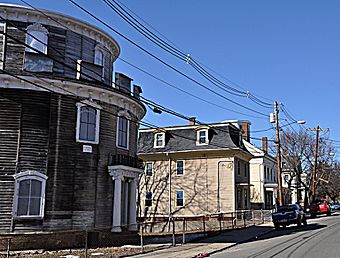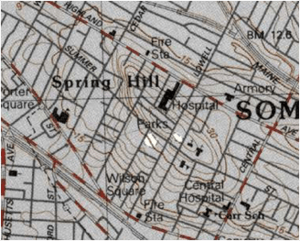Spring Hill, Somerville, Massachusetts facts for kids
Quick facts for kids |
|
|
Spring Hill Historic District
|
|

View of Atherton Street, including Somerville's Round House
|
|
| Location | Somerville, Massachusetts |
|---|---|
| Architect | Loring, George A. |
| Architectural style | Mid 19th Century Revival, Queen Anne, Shingle Style |
| MPS | Somerville MPS |
| NRHP reference No. | 89001222 |
| Added to NRHP | September 18, 1989 |
Spring Hill is a neighborhood in Somerville, Massachusetts. It sits on top of a ridge, which is a long, narrow hill. This area is located in the central part of Somerville. It stretches roughly between Highland Avenue, Somerville Avenue, Elm Street, and Willow Avenue. Summer Street runs right along the top of the hill.
Spring Hill is a special type of hill called a drumlin. Drumlins are hills shaped like upside-down spoons. They were formed by huge sheets of ice, called glaciers, that moved across the land a very long time ago. As the glaciers melted, they left behind piles of dirt and rocks, creating these hills. Many drumlins can be found around the Boston area.
For a long time, Spring Hill was mostly farmland. Not many houses were built there until the mid-1800s. Most of the neighborhood you see today was built between the 1840s and the early 1900s. You can find many beautiful old houses here. These include Greek Revival homes and different Victorian styles. Some examples are Second Empire, Italianate, Gothic Revival, and Queen Anne houses. Both large family homes and smaller houses for workers were built. In the early 1900s, triple-deckers (buildings with three apartments) filled in the last empty spaces.
A part of the Spring Hill neighborhood is very special. It was added to the National Register of Historic Places in 1989. This area is called the Spring Hill Historic District. It includes parts of Summer, Central, Atherton, and Spring Streets.
The Story of Spring Hill
The development of Spring Hill began in 1843. A very important businessman named George O. Brastow started it. He later became the first mayor of Somerville. Brastow created one of Somerville's first residential areas on the south side of the hill. This area was between Central and Belmont Streets.
Some of the first houses from this development are still standing today. You can see them on Atherton Street and near Harvard Street. A famous surveyor from Boston, Alexander Wadsworth, helped Brastow plan this new neighborhood. They wanted to attract wealthy families to build large homes on country-like properties. The area was popular because it had great views of Cambridge and Boston. It was also easy to get to Boston using the Fitchburg Railroad. Brastow's development is a key part of the Spring Hill Historic District.
In 1889, a tall water tower was built on the hill. It was located between Belmont and Lowell Streets, where Bailey Park is now. This tower helped bring clean drinking water to homes higher up on the hill. This made it easier for more houses to be built in the higher parts of the city.
By the end of the 1800s, most of the streets in Spring Hill were in place. The neighborhood became full of homes, many of them for multiple families. The area grew quickly because streetcar lines were extended from Lechmere Square. Also, more factories and businesses opened along Somerville Avenue and the Fitchburg Railroad.
Spring Hill is home to some important places. Somerville Hospital opened here in 1891 on Highland Avenue. The unique Round House is on Atherton Street. The Somerville Museum, which tells the story of the city, is located on Central Street.
Amazing Buildings and Landmarks
Many buildings in Spring Hill are so special that they are listed on the National Register of Historic Places. Spring Hill was mostly built for people to live in. So, most of its buildings are homes.
- The Enoch Robinson Round House is a very unusual building. It is shaped like a cylinder, or a can, and is made of wood. It was built in 1856 by Enoch Robinson, who made hardware. This house is a unique version of the octagon house style. It has been empty for many years but is now being slowly fixed up by new owners.
- The Martin W. Carr School was built in 1898. It used to be an elementary school. Today, the building has been changed into apartments called condominiums.
- The Alexander Foster House is an Italianate-style house. It was built in 1860 and is located on Laurel Street.
- The House at 16-18 Preston Road is a Colonial Revival style triple-decker. It was built in 1910.
- The Joseph K. James House is another Colonial Revival style house. It was built in 1893.
- The Lemuel Snow Jr. House is a beautiful Queen Anne style house. It was built in 1890.




